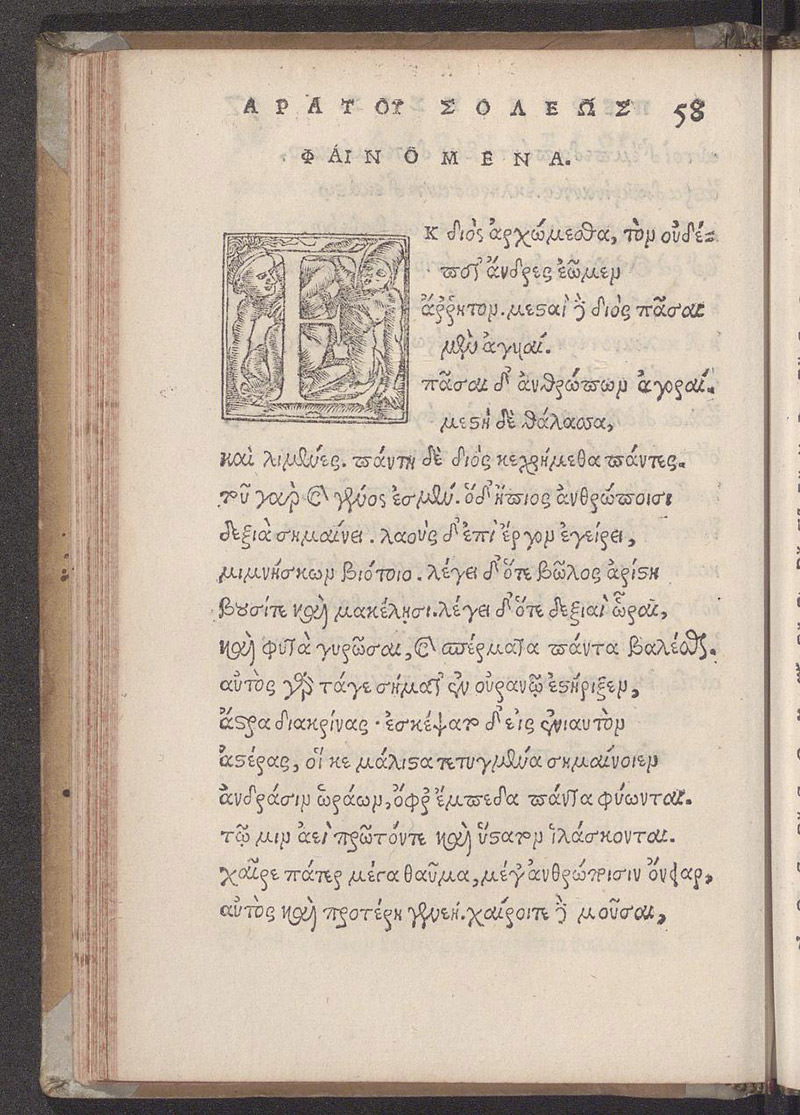Aratus’ Phaenomena: The Signs of Zeus and the Genre of Didactic Poetry

- Aratus, Phaenomena, lines 1-16.
- Dionysiou Oikoumenēs Periēgēsis. Aratou Phainomena. Proklou Sphaira. Dionysii orbis descriptio. Arati Astronomicon. Procli sphaera. (Thoma Linacro Britanno interprete). Cum scholiis Ceporini.
- Basel: Johann Bebel, 1523.
Aratus sometimes adds to his descriptions of constellations some mythical story (e.g., the Bears are identified with the nurses of Zeus and Virgo is identified with the goddess of Justice); yet his poem is mostly aimed at explaining the celestial phenomena displayed in the sky by Zeus.
The page here shown from another Renaissance edition by Jacobus Ceporinus (Basel, 1523) displays the beginning of the poem in which Aratus praises Zeus as follows (Phaen. 1-13):
From Zeus let us begin, whom we men never allow to be unnamed; full of Zeus are all the streets and all the market-places of people; full is the sea and the harbors; we all have need of Zeus, in everything. For we are also his offspring; and, as he is benevolent, he gives favorable [signs] to men and rouses people to work, reminding them of their livelihood. He tells when the soil is best for the oxen and mattocks, he tells when the seasons are favorable both for setting trees in a trench and for casting every type of seed. For he himself fixed the signs in the sky, distinguishing the constellations, and for the year he devised stars which should give to men especially well-defined signs of the seasons, so that everything may grow unfailingly. Therefore, they always invoke him first and last.
The signs sent by Zeus are of two types. Constellations and their risings and settings help humans calculate the passing of time. Other celestial bodies like the Moon and the Sun, as well as terrestrial signs like birds, animals and plants are useful to understand what weather we can expect. This information was useful to farmers and sailors, who both relied heavily on the weather and on the passing of seasons for cultivating the land or seafaring.
Despite its utility, the content is surprisingly technical to be the subject of a poem. In fact, the technical topic together with the sophisticated and often difficult diction suggest that the audience was the Hellenistic elite who could appreciate both the technicalities and the refined style. Indeed, in the Hellenistic period, when the Phaenomena were composed, many Greek poets wrote poems connected with technical subjects like drugs and poisons (Nicander of Colophon’s Theriaca and Alexipharmaca) and mathematics (Archimedes’ Cattle Problem). Aratus’ astronomical poem is thus part of a general trend of “scientific poetry”, which is typical of this period. In fact, the Phaenomena enjoyed enormous success. Whether or not this poem was used as a school text for astronomy as some scholars have claimed, it clearly attracted a vast readership. The success of a poem written by a non-professional astronomer stirred the reaction of the most important astronomer of the Hellenistic period, Hipparchus of Nicaea, who wrote an entire treatise to highlight all the mistakes and inaccuracies in Aratus’ poem. Yet Hipparchus’ project failed to have the same success, and the poem of Aratus remained popular through the Roman period and late antiquity.
Select Bibliography on Aratus and His Reception
- Gee, Emma. 2013. Aratus and the Astronomical Tradition. Classical Culture and Society. Oxford - New York: Oxford University Press.
- Kidd, Douglas. 1997. Aratus, Phaenomena, Edited with Introduction, Translation and Commentary. Cambridge Classical Texts and Commentaries. Cambridge - New York: Cambridge University Press.
- Martin, Jean. 1956. Histoire du texte des Phénomènes d'Aratos. Études et Commentaires. Paris: Klincksieck.
- Mastorakou, Stamatina. 2020. “Aratus and the Popularization of Hellenistic Astronomy.” In Hellenistic Astronomy: The Science in Its Contexts, edited by Alan C. Bowen and Francesca Rochberg, Leiden - Boston: Brill: 383-397.
- Taub, Liba Chaia. 2010. “Translating the « Phainomena » across genre, language and culture.” In Writings of early scholars in the Ancient Near East, Egypt, Rome, and Greece: translating ancient scientific texts, edited by Annette Imhausen and Tanja Pommerening, In Beiträge zur Altertumskunde, Berlin - New York: De Gruyter: 119-137.